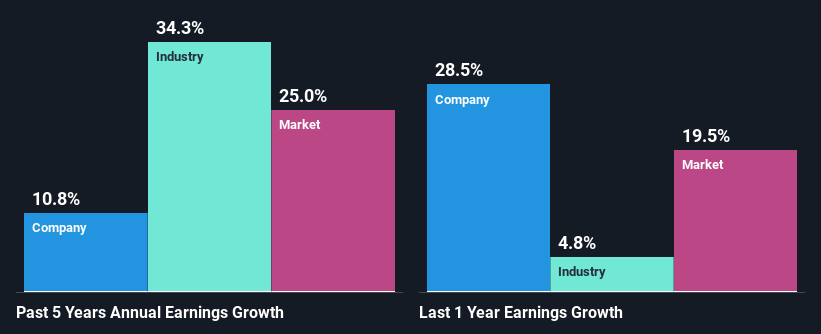Are The Shipping Corporation of India Limited's (NSE:SCI) Fundamentals Good Enough to Warrant Buying Given The Stock's Recent Weakness?
It is hard to get excited after looking at Shipping Corporation of India's (NSE:SCI) recent performance, when its stock has declined 20% over the past three months. But if you pay close attention, you might find that its key financial indicators look quite decent, which could mean that the stock could potentially rise in the long-term given how markets usually reward more resilient long-term fundamentals. Specifically, we decided to study Shipping Corporation of India's ROE in this article.
Return on Equity or ROE is a test of how effectively a company is growing its value and managing investors’ money. In other words, it is a profitability ratio which measures the rate of return on the capital provided by the company's shareholders.
How To Calculate Return On Equity?
ROE can be calculated by using the formula:
Return on Equity = Net Profit (from continuing operations) ÷ Shareholders' Equity
So, based on the above formula, the ROE for Shipping Corporation of India is:
12% = ₹9.7b ÷ ₹81b (Based on the trailing twelve months to December 2024).
The 'return' is the yearly profit. Another way to think of that is that for every ₹1 worth of equity, the company was able to earn ₹0.12 in profit.
Check out our latest analysis for Shipping Corporation of India
What Is The Relationship Between ROE And Earnings Growth?
We have already established that ROE serves as an efficient profit-generating gauge for a company's future earnings. Based on how much of its profits the company chooses to reinvest or "retain", we are then able to evaluate a company's future ability to generate profits. Assuming all else is equal, companies that have both a higher return on equity and higher profit retention are usually the ones that have a higher growth rate when compared to companies that don't have the same features.
A Side By Side comparison of Shipping Corporation of India's Earnings Growth And 12% ROE
When you first look at it, Shipping Corporation of India's ROE doesn't look that attractive. Yet, a closer study shows that the company's ROE is similar to the industry average of 11%. Even so, Shipping Corporation of India has shown a fairly decent growth in its net income which grew at a rate of 11%. Considering the moderately low ROE, it is quite possible that there might be some other aspects that are positively influencing the company's earnings growth. For example, it is possible that the company's management has made some good strategic decisions, or that the company has a low payout ratio.
As a next step, we compared Shipping Corporation of India's net income growth with the industry and were disappointed to see that the company's growth is lower than the industry average growth of 34% in the same period.

The basis for attaching value to a company is, to a great extent, tied to its earnings growth. It’s important for an investor to know whether the market has priced in the company's expected earnings growth (or decline). Doing so will help them establish if the stock's future looks promising or ominous. If you're wondering about Shipping Corporation of India's's valuation, check out this gauge of its price-to-earnings ratio, as compared to its industry.
Is Shipping Corporation of India Efficiently Re-investing Its Profits?
Shipping Corporation of India has a low three-year median payout ratio of 2.3%, meaning that the company retains the remaining 98% of its profits. This suggests that the management is reinvesting most of the profits to grow the business.
Besides, Shipping Corporation of India has been paying dividends over a period of five years. This shows that the company is committed to sharing profits with its shareholders.
Summary
In total, it does look like Shipping Corporation of India has some positive aspects to its business. Namely, its respectable earnings growth, which it achieved due to it retaining most of its profits. However, given the low ROE, investors may not be benefitting from all that reinvestment after all. While we won't completely dismiss the company, what we would do, is try to ascertain how risky the business is to make a more informed decision around the company. To know the 1 risk we have identified for Shipping Corporation of India visit our risks dashboard for free.
Have feedback on this article? Concerned about the content? Get in touch with us directly. Alternatively, email editorial-team (at) simplywallst.com.
This article by Simply Wall St is general in nature. We provide commentary based on historical data and analyst forecasts only using an unbiased methodology and our articles are not intended to be financial advice. It does not constitute a recommendation to buy or sell any stock, and does not take account of your objectives, or your financial situation. We aim to bring you long-term focused analysis driven by fundamental data. Note that our analysis may not factor in the latest price-sensitive company announcements or qualitative material. Simply Wall St has no position in any stocks mentioned.
 Wall Street Journal
Wall Street Journal